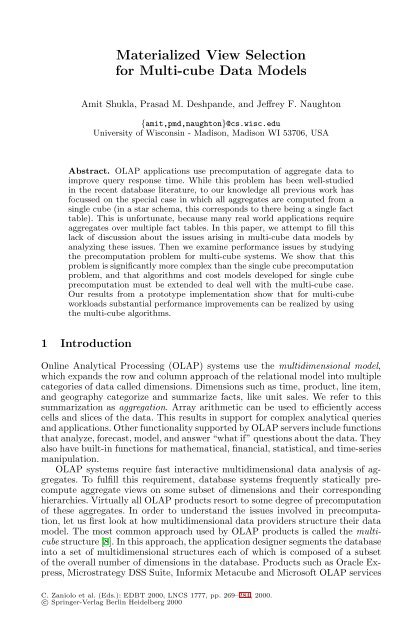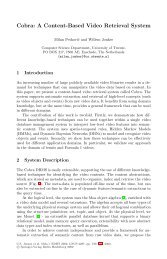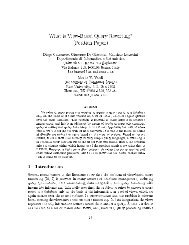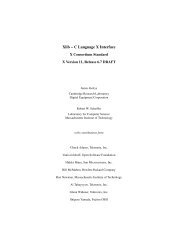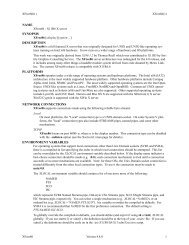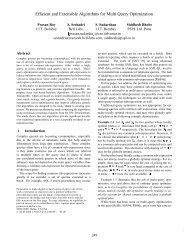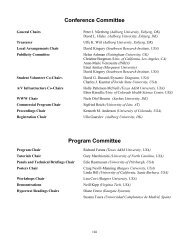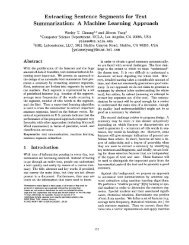Materialized View Selection for Multi-cube Data Models
Materialized View Selection for Multi-cube Data Models
Materialized View Selection for Multi-cube Data Models
You also want an ePaper? Increase the reach of your titles
YUMPU automatically turns print PDFs into web optimized ePapers that Google loves.
<strong>Materialized</strong> <strong>View</strong> <strong>Selection</strong><br />
<strong>for</strong> <strong>Multi</strong>-<strong>cube</strong> <strong>Data</strong> <strong>Models</strong><br />
Amit Shukla, Prasad M. Deshpande, and Jeffrey F. Naughton<br />
{amit,pmd,naughton}@cs.wisc.edu<br />
University of Wisconsin - Madison, Madison WI 53706, USA<br />
Abstract. OLAP applications use precomputation of aggregate data to<br />
improve query response time. While this problem has been well-studied<br />
in the recent database literature, to our knowledge all previous work has<br />
focussed on the special case in which all aggregates are computed from a<br />
single <strong>cube</strong> (in a star schema, this corresponds to there being a single fact<br />
table). This is un<strong>for</strong>tunate, because many real world applications require<br />
aggregates over multiple fact tables. In this paper, we attempt to fill this<br />
lack of discussion about the issues arising in multi-<strong>cube</strong> data models by<br />
analyzing these issues. Then we examine per<strong>for</strong>mance issues by studying<br />
the precomputation problem <strong>for</strong> multi-<strong>cube</strong> systems. We show that this<br />
problem is significantly more complex than the single <strong>cube</strong> precomputation<br />
problem, and that algorithms and cost models developed <strong>for</strong> single <strong>cube</strong><br />
precomputation must be extended to deal well with the multi-<strong>cube</strong> case.<br />
Our results from a prototype implementation show that <strong>for</strong> multi-<strong>cube</strong><br />
workloads substantial per<strong>for</strong>mance improvements can be realized by using<br />
the multi-<strong>cube</strong> algorithms.<br />
1 Introduction<br />
Online Analytical Processing (OLAP) systems use the multidimensional model,<br />
which expands the row and column approach of the relational model into multiple<br />
categories of data called dimensions. Dimensions such as time, product, line item,<br />
and geography categorize and summarize facts, like unit sales. We refer to this<br />
summarization as aggregation. Array arithmetic can be used to efficiently access<br />
cells and slices of the data. This results in support <strong>for</strong> complex analytical queries<br />
and applications. Other functionality supported by OLAP servers include functions<br />
that analyze, <strong>for</strong>ecast, model, and answer “what if” questions about the data. They<br />
also have built-in functions <strong>for</strong> mathematical, financial, statistical, and time-series<br />
manipulation.<br />
OLAP systems require fast interactive multidimensional data analysis of aggregates.<br />
To fulfill this requirement, database systems frequently statically precompute<br />
aggregate views on some subset of dimensions and their corresponding<br />
hierarchies. Virtually all OLAP products resort to some degree of precomputation<br />
of these aggregates. In order to understand the issues involved in precomputation,<br />
let us first look at how multidimensional data providers structure their data<br />
model. The most common approach used by OLAP products is called the multi<strong>cube</strong><br />
structure [8]. In this approach, the application designer segments the database<br />
into a set of multidimensional structures each of which is composed of a subset<br />
of the overall number of dimensions in the database. Products such as Oracle Express,<br />
Microstrategy DSS Suite, In<strong>for</strong>mix Meta<strong>cube</strong> and Microsoft OLAP services<br />
C. Zaniolo et al. (Eds.): EDBT 2000, LNCS 1777, pp. 269–284, 2000.<br />
c○ Springer-Verlag Berlin Heidelberg 2000
270 Amit Shukla, Prasad M. Deshpande, and Jeffrey F. Naughton<br />
all use the multi-<strong>cube</strong> approach. Un<strong>for</strong>tunately, to date, the research community<br />
has virtually ignored the precomputation problem over multi-<strong>cube</strong>s, concentrating<br />
instead on the simpler single–<strong>cube</strong> model. To our knowledge, this is the first paper<br />
to address the precomputation problem in the context of multi-<strong>cube</strong> domains.<br />
Thus, queries which access multiple <strong>cube</strong>s are not taken into account when making<br />
a decision of what group bys to precompute.<br />
The goal of this paper is twofold. First, to understand the ramifications of<br />
having a multi-<strong>cube</strong> data model, and second to understand the precomputation<br />
problem when there are queries which access multiple <strong>cube</strong>s. We examine existing<br />
techniques, and propose new techniques which can be utilized to solve this<br />
problem. We show that the multi-<strong>cube</strong> aggregate selection problem is significantly<br />
more complex than the single <strong>cube</strong> computation problem, and that algorithms<br />
and cost models developed <strong>for</strong> single <strong>cube</strong> precomputation must be extended to<br />
deal well with the multi-<strong>cube</strong> case. Our results show that <strong>for</strong> multi-<strong>cube</strong> workloads<br />
substantial per<strong>for</strong>mance improvements can be realized by using multi-<strong>cube</strong><br />
algorithms instead of previously proposed single <strong>cube</strong> algorithms.<br />
1.1 An Example Schema<br />
In this paper, <strong>for</strong> clarity of exposition we will assume a Relational approach to<br />
OLAP. This means that each “<strong>cube</strong>” of a multi-<strong>cube</strong> model corresponds to a fact<br />
table. However, the material presented in this paper is not restricted to the relation<br />
model.<br />
Consider a schema which consists of three dimensions, CustID, ProdID, and<br />
TimeID. They identify a customer, a product, and the time (in months). The<br />
schema has three fact tables. The first is Sales, a row of which captures the dollar<br />
sales and unit sales of a particular product by a certain store in some month. The<br />
second fact table is ProdCost, and it captures the cost of products on a month<br />
by month basis. The third table captures the shipping cost of products to various<br />
customers, and is called ShipCost.<br />
Sales(ProdID, CustID, TimeID, Sales, UnitsSold)<br />
ProdCost(ProdID, TimeID, PCost)<br />
ShipCost(CustID, TimeID, SCost)<br />
A user can specify “derived” or computed metrics, which are <strong>for</strong>med as a combination<br />
of other metrics. If the component metrics belong to different fact tables,<br />
then a join is required to generate the derived metric. For example, a “derived<br />
metric” called Profit = (Sales - UnitsSold * (PCost + SCost)), which is obtained<br />
from the natural join of the ProdCost and Sales tables along the ProdID, TimeID<br />
dimensions. Any queries which involve the Profit metric will require a join to<br />
be per<strong>for</strong>med, unless the join is precomputed. For example, the following query<br />
requires a join:<br />
SELECT Sales.CustID, SUM(Sales - UnitsSold * (PCost + SCost))<br />
FROM ProdCost, ShipCost, Sales<br />
WHERE ProdCost.ProdID = Sales.ProdID AND ProdCost.TimeID = Sales.TimeID<br />
AND ShipCost.CustID = Sales.CustID AND ProdCost.TimeID = Sales.TimeID<br />
GROUP BY Sales.CustID<br />
1.2 Related Work<br />
To find a set of aggregates to materialize, [7] proposes a greedy algorithm that<br />
attempts to maximize the benefit per unit space. They prove that if the largest<br />
aggregate view occupies a fraction f of the space available <strong>for</strong> precomputation,
<strong>Materialized</strong> <strong>View</strong> <strong>Selection</strong> <strong>for</strong> <strong>Multi</strong>-<strong>cube</strong> <strong>Data</strong> <strong>Models</strong> 271<br />
then the aggregates picked by the greedy algorithm have a benefit at least (0.63−f)<br />
times the benefit of the optimal set of views <strong>for</strong> the same amount of space. The<br />
greedy algorithm restricts itself to a single <strong>cube</strong> data model.<br />
Other related work includes [10] where the authors explore efficient algorithms<br />
<strong>for</strong> aggregate selection <strong>for</strong> single <strong>cube</strong> schemas. In [5], the authors consider the<br />
selection of views and indexes together. [6] presents a theoretical framework <strong>for</strong><br />
the view-selection problem, and proposes a general algorithm and several heuristics.<br />
[13] surveys techniques proposed <strong>for</strong> determining what aggregates should be<br />
precomputed. When lattices are so large that even scanning them once is expensive,<br />
a different approach to precomputation is needed. [2] examine lattices with<br />
10 13 aggregate views. For such lattices, they provide heuristics to determine what<br />
views should be precomputed based a set of views the user supplies. All these papers<br />
([13,5,6,2]) examine the aggregate selection problem in the context of a single<br />
<strong>cube</strong>. Finally, Shukla discusses aggregate selection algorithms in detail in [11].<br />
1.3 Paper Organization<br />
In section 2 we describe the lattice framework and cost model <strong>for</strong> the aggregate<br />
selection problem. We also describe an existing aggregate selection algorithm. Section<br />
3 discusses the issues that arise when joining multiple <strong>cube</strong>s and precomputing<br />
their joins. Section 4 presents greedy algorithms <strong>for</strong> aggregate selection <strong>for</strong><br />
multi-<strong>cube</strong> schemas. We carry out an experimental evaluation of the different precomputation<br />
algorithms in Section 5, and present insights into the problem of<br />
aggregate selection. Section 6 presents our conclusions.<br />
2 Previous Work on Precomputation<br />
In this section we first discuss the lattice framework <strong>for</strong> multidimensional datasets.<br />
This framework was first proposed by Harinarayan et al. [7]. Next we present the<br />
cost model <strong>for</strong> single <strong>cube</strong> schemas proposed by [7], and used in subsequent research<br />
[13,5,2,10]. In order to handle multi-<strong>cube</strong> schemas, we extend the single<br />
<strong>cube</strong> cost model to account <strong>for</strong> join costs required to compute derived metrics.<br />
Shukla et al. [10] had proposed an average query cost metric which makes visualization<br />
of the “goodness” of the aggregate set selected <strong>for</strong> precomputation easier.<br />
We repeat a description of average query cost in Section 2.4.<br />
2.1 Lattice Framework <strong>for</strong> <strong>Multi</strong>dimensional <strong>Data</strong>sets<br />
Queries on multidimensional datasets can be modeled by the data <strong>cube</strong> operator.<br />
For distributive function such as sum, min, max, etc., some group bys can be<br />
computed from the precomputed result of another group by. In the example Sales<br />
table of Section 1.1, the aggregate on (ProdID, CustID) can be used to answer a<br />
query on (ProdID). This relation between aggregate views can be used to place<br />
them within a lattice framework as proposed in [7]. Aggregates are vertices of<br />
an n-dimensional <strong>cube</strong>. The following properties define a hyper<strong>cube</strong> lattice L of<br />
aggregates.<br />
(a) There exists a partial order ≼ between aggregate views in the lattice. For<br />
aggregate views u and v, v ≼ u if and only if v can be answered using the<br />
results of u by itself.
272 Amit Shukla, Prasad M. Deshpande, and Jeffrey F. Naughton<br />
(b) There is a base view in the lattice, upon which every view is dependent. The<br />
base view is the database.<br />
(c) There is a completely aggregated view “ALL”, which can be computed from<br />
any other view in the lattice.<br />
The aggregate selection problem is equivalent to selecting vertices from the underlying<br />
hyper<strong>cube</strong> lattice. For example, the lattice L in Figure 1 represents the <strong>cube</strong><br />
of the schema described in Section 1.1. The three dimensions ProdID, CustID,<br />
TimeID are represented by P, C, T respectively, and an aggregate view is labeled<br />
using the names of the attributes it is aggregated on. For example, view PC is<br />
aggregated on attributes ProdID and CustID. In Figure 1, if an edge connects<br />
two views, then the higher view can be used to precompute the other view. For<br />
example, there is an edge between PC and P. This means that PC can be used<br />
to compute P. If there is no precomputation, a query on P (ProdID) has to be<br />
answered using the base data, PCT (Sales table). When there are multiple <strong>cube</strong>s,<br />
we have a collection of lattices from which aggregates have to be picked <strong>for</strong> precomputation.<br />
PCT<br />
PC<br />
PT<br />
CT<br />
P<br />
C<br />
T<br />
ALL<br />
Fig. 1. The hyper<strong>cube</strong> lattice corresponding to the example in Section 1.1.<br />
2.2 The Cost Model<br />
We use the cost model proposed by [7], in which the cost of answering a query (time<br />
of execution) is assumed to be equal to the number of tuples in the aggregate used<br />
to answer the query. An experimental validation of this cost model is provided in<br />
[7], where the authors used experiments on TPC-D Benchmark data. They found<br />
that there is an almost linear relationship between size and running time of a<br />
query. In summary, we assume that the cost of answering a query q is equal to the<br />
number of tuples read to return the answer.<br />
2.3 The Benefit Metric<br />
In<strong>for</strong>mally, the benefit of an aggregate view v is computed by adding up the savings<br />
in query cost <strong>for</strong> each view w (including v), over answering it from the base view.<br />
If a set S of aggregate views is chosen <strong>for</strong> materialization, the benefit of S is the<br />
sum of the benefits of all views in S. This is similar to the metric used by [7].<br />
We now <strong>for</strong>mally define the benefit of an aggregate view. If S is a set of aggregates<br />
that have already been selected <strong>for</strong> precomputation, the benefit of a view v is<br />
concerned with how materializing v improves the cost of computing other views,<br />
including itself. Let C(v) be the cost of computing another view from v. Looking<br />
back to our cost model, C(v) is the number of tuples in v. The benefit of v with<br />
respect to the S, B(v, S), is defined below.
<strong>Materialized</strong> <strong>View</strong> <strong>Selection</strong> <strong>for</strong> <strong>Multi</strong>-<strong>cube</strong> <strong>Data</strong> <strong>Models</strong> 273<br />
1. For each aggregate view u ≼ v, B u is defined as:<br />
1.1 Let w be the least cost view in S such that u ≼ w<br />
1.2 If C(v) < C(w), then B u = C(w) − C(v), else B u =0<br />
2. B(v, S) = ∑ u≼v B u<br />
In short, <strong>for</strong> each view u that is a descendant of v, we check to see if computing u<br />
from v is cheaper than computing u from any other view in the set S. If this is the<br />
case, then precomputing v benefits u. Since all aggregates can be computed from<br />
the (unaggregated) base data, in step 1.1 we can always find a least cost aggregate<br />
view w (the base data in the worst case).<br />
Definition 1. The benefit per unit space of a view v is defined as:<br />
B s (v, S) =<br />
B(v, S)<br />
, where |v| is the size of v<br />
|v|<br />
2.4 Average Query Cost<br />
Next, consider a set of lattices L with n views, v 1 ,...,v n . There are n different templates<br />
<strong>for</strong> queries, one <strong>for</strong> each view: Q 1 , Q 2 ,...,Q n . Let there be a set S of aggregate<br />
views precomputed, so that a query of view v i can be most cheaply answered<br />
from a view u i , u i ∈S. Let queries on S occur with probabilities p 1 ,p 2 ,...,p n ,<br />
then the average query cost is defined as:<br />
1<br />
n∑<br />
n · p i C(u i ), (1)<br />
i=1<br />
where C(u i ) is the cost of answering a query Q i on a view v i . In [10], we show that<br />
maximizing the benefit of a set S of aggregate views is the same as minimizing<br />
their average query cost.<br />
2.5 Aggregate <strong>Selection</strong><br />
PickAggregates is a greedy algorithm proposed by Ullman etal. [7] to select aggregates<br />
<strong>for</strong> precomputation based on the above benefit model. The inputs to<br />
PickAggregates are: space – the amount of space available <strong>for</strong> precomputation,<br />
and A, a set initially containing all aggregates in the lattice, except the base table.<br />
The output is S, the set of aggregates to be precomputed. The algorithm is<br />
as follows:<br />
Algorithm PickAggregates<br />
WHILE (space > 0) DO<br />
w = aggregate having the maximum benefit per unit space in A<br />
IF (space −|w| > 0) THEN<br />
space = space −|w|<br />
S = S∪w<br />
A = A−w<br />
˙ELSE<br />
space = 0<br />
˙Update the benefit of affected nodes in the lattice<br />
S is the set of aggregates picked by BPUS
274 Amit Shukla, Prasad M. Deshpande, and Jeffrey F. Naughton<br />
The notion of benefit used by the above algorithm was described in Section 2.3.<br />
PickAggregates attempts to maximize the benefit of the set of aggregates picked.<br />
The authors prove that if the largest aggregate view occupies a fraction f of the<br />
space available <strong>for</strong> precomputation, then the aggregates picked by BPUS have a<br />
benefit at least (0.63−f) times the benefit of the optimal set of views <strong>for</strong> the same<br />
amount of space.<br />
3 Issues in <strong>Multi</strong>-<strong>cube</strong> <strong>Models</strong><br />
In order to discuss precomputation <strong>for</strong> multi-<strong>cube</strong> data models, it is necessary to<br />
define the semantics of queries over multi-<strong>cube</strong> models. For concreteness, in this<br />
section we discuss the issues that arise in queries over multi-<strong>cube</strong> models, and<br />
state the conventions we will follow when dealing with queries over multi-<strong>cube</strong>s.<br />
We start by looking at the semantics of multidimensional queries.<br />
3.1 <strong>Multi</strong>dimensional Query Semantics<br />
The multidimensional model expands the row and column approach of the relational<br />
model into multiple categories of data called dimensions. Dimensions such<br />
as time, product, line item, and geography categorize and summarize facts, like<br />
unit sales. Users can ask analytical queries using a multidimensional query tool.<br />
A multidimensional query consists of the dimensions of interest (such as time,<br />
product), the fact to be summarized (like unit sales), and conditions (such as time<br />
equals january 1999). If the query accesses multiple <strong>cube</strong>s, then the data model<br />
implicitly specifies the procedure to join the two <strong>cube</strong>s. There<strong>for</strong>e, in this paper<br />
we adopt standard multidimensional semantics [12], which state that one should<br />
join on all the dimensions common to the <strong>cube</strong>s being joined.<br />
Definition 2. The columns used to join two fact tables are called their “join dimensions”.<br />
The join dimensions between two tables include all their common dimensions.<br />
For example, from the schema of section 1.1, the join dimensions between Sales<br />
and ProdCost are ProdID, TimeID. Based on this definition of join dimensions,<br />
we can define our notation <strong>for</strong> uniquely identifying a group by.<br />
Definition 3. Let D i represent a dimension, F j represent a distributive aggregation<br />
function such as sum, min, max, and M k represent a metric. Then the results<br />
of the queryget D 1 ,...,D n ,F 1 (M 1 ),...,F r (M r ), can be represented compactly as<br />
(D 1 ,...,D n ) F1(M 1),...,F r(M r)<br />
For example using this definition, the query: get ProdID, CustID, SUM(Sales) will<br />
be represented by (ProdID, CustID) SUM(Sales) . In order to simplify the notation,<br />
we assume that if the aggregation function is not specified, then it is SUM. There<strong>for</strong>e,<br />
the above query can be rewritten as (ProdID, CustID) Sales . A corollary of<br />
this assumption by multidimensional query tools is that multidimensional queries<br />
are restricted to a subset of SQL in that one cannot express different ways of<br />
joining two fact tables - one always has to join on all the common dimensions.<br />
3.2 Precomputed Joins<br />
Let us look at the benefits of precomputing aggregates that result from joining<br />
multiple <strong>cube</strong>s. Our goal is to investigate the approach of computing the join of<br />
all the <strong>cube</strong>s. Precomputing the join of all the <strong>cube</strong>s creates a single large table
<strong>Materialized</strong> <strong>View</strong> <strong>Selection</strong> <strong>for</strong> <strong>Multi</strong>-<strong>cube</strong> <strong>Data</strong> <strong>Models</strong> 275<br />
that is in effect the “universal relation” [14], of which the multiple fact tables<br />
are projections. We scrutinize this approach to understand if it will enable us to<br />
apply single-table aggregate selection algorithms immediately. We show that this<br />
approach is fraught with hazards.<br />
Consider the tables from the schema of Section 1.1. At a first glance, it seems<br />
as if we can extend the idea of precomputation of aggregates <strong>for</strong>med from a single<br />
fact table to precomputing aggregates <strong>for</strong>med from joins between fact tables. If<br />
we per<strong>for</strong>m an equi-join between the two tables ShipCost and Sales,<br />
SELECT Sales.CustID, Sales.ProdID, Sales.TimeID, SUM (Sales), SUM (SCost)<br />
FROM Sales, ShipCost<br />
WHERE Sales.CustID = ShipCost.CustID<br />
AND Sales.TimeID = ShipCost.TimeID<br />
GROUP BY Sales.CustID, Sales.ProdID, Sales.TimeID<br />
to obtain a new table T e with the schema T e (CustID, ProdID, TimeID, S Sales,<br />
S SCost). This new table T e can be precomputed and materialized in the database.<br />
However, T e can be used only by queries which require a join of Sales and ShipCost.<br />
That is, T e cannot be used to answer queries which access only one of the joined<br />
tables. This leads us to examine whether we can use full outer joins between tables<br />
to solve this problem.<br />
When we per<strong>for</strong>m the natural join between two tables ShipCost and Sales,<br />
only tuples from ShipCost that have matching tuples in Sales – and vice versa –<br />
appear in the result. Hence, tuples without a “related tuple” are eliminated from<br />
the result. Outer joins [3] were proposed to be used when one wants to retain<br />
all tuples from both tables being joined. In our example, an outer join between<br />
ShipCost and Sales would include tuples from both tables that join with each other<br />
as well as tuples that belong to only ShipCost, and only Sales, whether or not they<br />
have matching tuples in the other relation. Now, suppose that we per<strong>for</strong>m a full<br />
outer join between the ShipCost and Sales tables.<br />
SELECT Sales.CustID, Sales.ProdID, Sales.TimeID, SUM (Sales), SUM (SCost)<br />
FROM Sales, ShipCost<br />
WHERE Sales.ProdID(+) = ShipCost.ProdID(+)<br />
AND Sales.TimeID(+) = ShipCost.TimeID(+)<br />
GROUP BY Sales.CustID, Sales.ProdID, Sales.TimeID<br />
In the above SQL, the (+) notation is used to denote an outer join. The outer join<br />
results in a new table T o with the schema T o (CustID, ProdID, TimeID, S Sales,<br />
S SCost). The queries (TimeID) SCost and (TimeID) Sales can be answered using<br />
the following SQL statements:<br />
SELECT TimeID, SUM (SCost)<br />
FROM T o<br />
WHERE SCost is NOT NULL<br />
GROUP BY TimeID<br />
SELECT TimeID, SUM (Sales)<br />
FROM T o<br />
WHERE Sales is NOT NULL<br />
GROUP BY TimeID<br />
On the other hand, to answer a query on (CustID, TimeID) Sales requires the SQL.<br />
SELECT CustID, TimeID, SUM (Sales)<br />
FROM T o<br />
WHERE Sales is NOT NULL<br />
AND SCost is NOT NULL<br />
GROUP BY CustID, TimeID
276 Amit Shukla, Prasad M. Deshpande, and Jeffrey F. Naughton<br />
For one derived metric, there are three possible aggregates which can be queried.<br />
Let us look at what happens when we join in a third table, ProdCost to T o<br />
using an outer join. The aggregates which can be queried are: (TimeID) Sales ,<br />
(TimeID) Sales,SCost , (TimeID) PCost , (TimeID) SCost,PCost , (TimeID) SCost,Sales ,and<br />
(TimeID) PCost,Sales , (TimeID) SCost,PCost,Sales . If we try to precompute aggregates<br />
from T o , it is not clear which aggregate should be precomputed. The table used<br />
by (TimeID) Sales cannot be used to answer (TimeID) Sales,SCost . Hence both aggregates<br />
have to considered separately by an aggregate selection algorithm <strong>for</strong><br />
precomputation. This negates the advantage of having a single lattice. Besides,<br />
this goes against the data model design, which splits this one table into multiple<br />
tables <strong>for</strong> reasons of efficient storage, and to avoid the various anomalies associated<br />
with denormalized schemas. Clearly, it makes sense to precompute the natural join<br />
and compute the derived metric. In the above example, we would precompute T ⊲⊳<br />
=T e (CustID, ProdID, TimeID, Profit), where Profit = (Sales - UnitsSold∗(SCost<br />
- PCost)). This avoids the repetition of SCost <strong>for</strong> each ProdID, and repeating the<br />
PCost <strong>for</strong> each CustID.<br />
From this discussion it is clear that the single universal relation like table approach<br />
is fraught with difficulty. This single table must be materialized from a full<br />
multi-way outer join. It is likely to be very large, and to contain a lot of redundant<br />
in<strong>for</strong>mation. Finally, mapping multidimensional queries to this single table is likely<br />
to be inefficient because each aggregate requires a slightly different NULL value<br />
filtering, and the NULL filtering itself must be per<strong>for</strong>med. Accordingly, we look<br />
<strong>for</strong> alternative approaches to speeding up OLAP queries using precomputation in<br />
section 4.<br />
3.3 <strong>Multi</strong>-<strong>cube</strong> Join Quirks<br />
Let us look at the various issues that arise when multiple-<strong>cube</strong>s are joined, and<br />
their join is precomputed. The basis of star schema data modelling is that the<br />
dimensions determine the measures and there are no other dependencies. That is,<br />
the metrics in a table are functionally dependent on the dimensions. If the base<br />
data consists of aggregate views of some base schema, then we cannot synthesize<br />
a lost dimension using joins. Let us assume that the following functional dependencies<br />
exist: CPT → Sales; PT → PCost, where C, P, and T stand <strong>for</strong> CustID,<br />
ProdID, and TimeID respectively. But if the tables in the database are actually:<br />
SalesNoTime(ProdID, CustID, Sales, UnitsSold)<br />
ProdCost(ProdID, TimeID, PCost)<br />
Then, one cannot join the two tables to get (TimeID) Sales . We call such an aggregate<br />
a “phantom” table since it can be obtained from the original data, but not<br />
from the derived view.<br />
Another interesting quirk arises when per<strong>for</strong>ming a join between two tables;<br />
one cannot aggregate out a join column be<strong>for</strong>e per<strong>for</strong>ming the join. This leads to<br />
a lossy join in the sense that we lose the ability to distinguish which tuple should<br />
be in the result. For example, in the following schema,<br />
Sales(ProdID, CustID, TimeID, Sales, UnitsSold)<br />
CustCost(ProdID, CustID, TimeID, Cost)<br />
with the functional dependencies CPT → Sales, PTC → Cost, if the join columns<br />
are ProdID (P), CustID (C), and TimeID (T), then we cannot join the aggregate<br />
(CustID, ProdID) Sales with (ProdID, CustID, TimeID) Cost to compute the result<br />
of a query. This importance of the need <strong>for</strong> this discussion will become clearer<br />
when we consider join benefits of aggregate nodes in a lattice.
<strong>Materialized</strong> <strong>View</strong> <strong>Selection</strong> <strong>for</strong> <strong>Multi</strong>-<strong>cube</strong> <strong>Data</strong> <strong>Models</strong> 277<br />
3.4 The Subset Assumption<br />
Now we discuss the subset assumption, and show how query semantics can be<br />
ambiguous without it. Consider a query which joins the ProdCost and ShipCost<br />
tables from the schema described in Section 1.1. The functional dependencies are:<br />
PT → PCost, CT → SCost. Neither of these two fact tables is contained in the<br />
other. This leads to interesting queries such as (Customer) PCost which are ambiguous<br />
since they can be obtained using either of the following two SQL statements.<br />
SELECT ShipCost.Customer, SUM (PCost)<br />
FROM ShipCost, ProdCost<br />
WHERE ShipCost.Time = ProdCost.Time<br />
GROUP BY ShipCost.Customer<br />
SELECT ShipCost.Customer, T1.Sum PCost<br />
FROM ShipCost, (SELECT SUM(PCost) AS Sum PCost<br />
FROM ProdCost) T1<br />
The first SQL query joins the two tables on their join dimensions, which leads to<br />
an answer which may not have any meaning. The second SQL query computes the<br />
total product cost and repeats it <strong>for</strong> each customer. This might be more accurate<br />
in capturing what the user wants since the product cost is not dependent on the<br />
Customer attribute. We define “dimensional containment”, which makes it easier<br />
to define what joins will result in meaningful results.<br />
Definition 4. When the dimensions of one fact table T 1 are a subset of the dimensions<br />
of another fact table T 2 ,thenT 2 is said to dimensionally contain T 1 .<br />
Since query semantics are ambiguous without it, we assume that when two or<br />
more tables are joined, one of the tables dimensionally contains the others. For<br />
example, from Section 1.1, the Sales table dimensionally contains both ShipCost<br />
and ProdCost. Tables dimensionally contained by the Sales table can be joined<br />
through it to answer queries. For example, a query such as (CustID) PCost can be<br />
unambiguously answered using the following SQL:<br />
SELECT Sales.CustID, SUM (ProdCost.PCost)<br />
FROM Sales, ProdCost<br />
WHERE Sales.Product = ProdCost.Product<br />
AND Sales.Time = ProdCost.Time<br />
GROUP BY Sales.CustID<br />
Next we examine the precomputation problem <strong>for</strong> multi-<strong>cube</strong> systems. We start<br />
with a framework <strong>for</strong> multidimensional datasets.<br />
4 New Aggregate <strong>Selection</strong> Techniques <strong>for</strong> <strong>Multi</strong>-<strong>cube</strong>s<br />
In this section we first extend the cost model to account <strong>for</strong> the benefits of aggregates<br />
arising from the existence of multiple <strong>cube</strong>s. Then, we propose aggregate<br />
selection algorithms based on the new benefit model.<br />
4.1 Benefits across <strong>Multi</strong>ple Cubes<br />
Let us look at the lattices L 1 , L 2 <strong>for</strong> two <strong>cube</strong>s with schemas T 1 (A,B,M 1 )and<br />
T 2 (A,B,C,M 2 ), where A, B, C are the dimensions, and M 1 ,M 2 are the measures.<br />
To obtain an aggregate containing a derived metric composed of metrics from both<br />
<strong>cube</strong>s, we have to join the two tables. In the multi-<strong>cube</strong> scenario, each precomputed<br />
aggregate can potentially have a join benefit in addition to the simple benefit
278 Amit Shukla, Prasad M. Deshpande, and Jeffrey F. Naughton<br />
AB<br />
ABC<br />
ABC<br />
AB<br />
CA<br />
BC<br />
AB<br />
CA<br />
BC<br />
A<br />
B<br />
A B C<br />
A B C<br />
ALL<br />
ALL<br />
ALL<br />
Fig. 2. Lattice L 1<br />
Fig. 3. Lattice L 2<br />
Fig. 4. Lattice L ⊲⊳<br />
described in section 2.3. The benefit of the aggregate L 2 (A,B) is larger because<br />
any aggregate which required the join of L 1 (A,B) with L 2 (A,B,C) can now be<br />
obtained by joining L 1 (A,B) with L 2 (A,B). Thus, the precomputation of L 2 (A,B)<br />
has a benefit to its children in L 2 , and a benefit to the aggregates having derived<br />
metrics which result from a join. Let us quantify this join benefit.<br />
We assume that joins are per<strong>for</strong>med using a hash join based algorithm. So,<br />
if nodes L 1 (A,B) and L 2 (A,B) are joined to answer the query, then we assume<br />
that each node is scanned and partitioned on the join dimensions, and written<br />
to disk. Then these partition are read in to per<strong>for</strong>m the join. There<strong>for</strong>e, counting<br />
only I/O costs (as we have been doing so far), the join cost is approximately<br />
equal to 2(|L 1 (A, B)| + |L 2 (A, B)|). The derived metric results in a virtual lattice<br />
L ⊲⊳ (see Figures 2, 3, and 4). The aggregate L 2 (A,B) benefits L ⊲⊳ (A,B) and all<br />
its descendants. The cost savings from precomputing L 2 (A,B) (ie, the benefit of<br />
L 2 (A,B)) are computed as follows: 2(|L 1 (A, B)| + |L 2 (A, B, C)|) − 2(|L 1 (A, B)| +<br />
|L 2 (A, B)|) which is equal to 2(|L 2 (A, B, C)| −|L 2 (A, B)|). The benefit per unit<br />
space of L 2 (A,B) increases by<br />
J s (L 2 (A, B), S) = 2(|L 2(A, B, C)|−|L 2 (A, B)|)<br />
∗(# benefited nodes in other lat.)<br />
|L 2 (A, B)|<br />
where J s denotes the join benefit of L 2 (A, B), and S is the set of aggregates already<br />
selected <strong>for</strong> precomputation. In addition, the number of nodes in L 1 benefited<br />
by the precomputation of L 2 (A, B) is4(namely,L 1 (A, B), L 1 (A), L 1 (B), and<br />
L 1 (ALL). From the discussion in section 3.3 about multi-<strong>cube</strong> join semantics, one<br />
should note however that the number of benefitted join nodes can be zero. For<br />
example, neither L 1 (A) norL 2 (A) have any join benefit since joining either node<br />
with a node in the other lattice does not lead to a semantically valid answer. Thus<br />
we can define the total benefit of L 2 (A, B) as:B s (L 2 (A, B), S)+J s (L 2 (A, B), S)<br />
We define the principal lattice as the lattice that dimensionally dominates all the<br />
other tables in the join. For example, L 2 is the principal lattice <strong>for</strong> the derived<br />
metric obtained by joining L 2 (A, B, C) withL 1 (A, B) (see Figure 3). Aggregates<br />
from lattice L 1 cannot be used in a join to obtain any nodes in L ⊲⊳ as it violates<br />
the rule that one cannot aggregate out a join column be<strong>for</strong>e per<strong>for</strong>ming the join<br />
(see section 3.3). Thus, only aggregates from the principal lattice can be used, and<br />
the dimensions of the least aggregated node of the principal node must contain<br />
the join dimensions. For example, the least aggregated node of L 2 than can be<br />
used is (A,B).
<strong>Materialized</strong> <strong>View</strong> <strong>Selection</strong> <strong>for</strong> <strong>Multi</strong>-<strong>cube</strong> <strong>Data</strong> <strong>Models</strong> 279<br />
Simple<br />
Cost Model<br />
Complex<br />
Space Allocation<br />
Local<br />
Global<br />
Fig. 5. The different multi-<strong>cube</strong> algorithm strategies<br />
4.2 Aggregate <strong>Selection</strong> <strong>for</strong> <strong>Multi</strong>-<strong>cube</strong>s<br />
Now we present three algorithms that pick aggregates <strong>for</strong> schemas having multi<strong>cube</strong><br />
data models. There are two different parameters that we vary to obtain<br />
different algorithms <strong>for</strong> aggregate selection. The first is the space allocation strategy,<br />
which can be either local or global. Local space allocation means that the<br />
available space <strong>for</strong> precomputation is divided up among the <strong>cube</strong>s, and aggregate<br />
selection algorithms are then run on each <strong>cube</strong>. Global space allocation means that<br />
space is not divided among the <strong>cube</strong>s, and aggregate selection algorithms pick the<br />
best aggregates from all <strong>cube</strong>s simultaneously. The second parameter is the cost<br />
model. The cost model can be simple (as described in section 2.3, which doesn’t<br />
consider derived metrics and virtual <strong>cube</strong>s, or complex (as described in section 4.1,<br />
which accounts <strong>for</strong> the benefit arising from the joins required by derived metrics.<br />
The complex cost model was described in Section 4.1. The algorithms which result<br />
from varying these two parameters can be classified using the grid in Figure 5.<br />
We will refer to the four algorithms by combining the type of cost model followed<br />
by the space allocation strategy. For example, ComplexGlobal refers to the<br />
algorithm which uses the complex cost model and a global space allocation strategy.<br />
The algorithm which results from using the complex cost model and a local<br />
space allocation strategy doesn’t make sense since the cost model captures benefits<br />
across <strong>cube</strong>s, but the space allocation is local to each <strong>cube</strong>. There<strong>for</strong>e, we don’t<br />
discuss the ComplexLocal algorithm. We will study the SimpleLocal, SimpleGlobal,<br />
and ComplexGlobal algorithms. The experimental studies will compare the Simple<br />
and Complex cost models to quantify the improvement in query response time<br />
obtained by using the complex cost model.<br />
The algorithm SimpleLocal works by dividing the space among the <strong>cube</strong>s, and<br />
then executing the algorithm PickAggregates on each <strong>cube</strong>. The inputs to Pick-<br />
Aggregates are: space – the amount of space available <strong>for</strong> precomputation, and A,<br />
a set initially containing all aggregates in the lattice, except the base table. The<br />
output is S, the set of aggregates to be precomputed. The algorithm is as follows:<br />
Algorithm PickAggregates<br />
WHILE (space > 0) DO<br />
w = aggregate having the maximum simple benefit per unit space in A<br />
IF (space −|w| > 0) THEN<br />
space = space −|w|<br />
S = S∪w<br />
A = A−w<br />
˙ELSE<br />
space = 0<br />
˙Update the benefit of affected nodes in the lattice<br />
S is the set of aggregates picked by BPUS
280 Amit Shukla, Prasad M. Deshpande, and Jeffrey F. Naughton<br />
SimpleGlobal differs from SimpleLocal in that the set of aggregates it has to choose<br />
from is the union of the sets of aggregates from each <strong>cube</strong>. There<strong>for</strong>e, <strong>for</strong> Simple-<br />
Global, A, is a set initially containing all aggregates in all the lattices, except the<br />
base tables of those lattices. ComplexGlobal differs from SimpleGlobal only in the<br />
second step of the algorithm.<br />
w = aggregate having the maximum complex benefit per unit space in A<br />
The series of steps required to update the benefits of the aggregates in the lattices<br />
<strong>for</strong> ComplexGlobal is interesting. Thus a brief description is presented next.<br />
Algorithm UpdateBenefits<br />
IF the aggregate is picked from a virtual lattice<br />
Update aggregates in the virtual lattice<br />
A node in the Principal lattice has a reduced benefit<br />
ELSE<br />
Update aggregates in the lattice<br />
Update the cheapest parent <strong>for</strong> any affected Virtual lattices<br />
also update the benefit of the previous cheapest parent.<br />
Let us examine these steps in a little more detail. At each step the greedy algorithm<br />
picks the aggregate with the highest benefit. If the aggregate v with the maximum<br />
benefit is from a virtual lattice, then we have to first update all descendants of v<br />
to see if they can now be computed less expensively using v. The benefit of all the<br />
ancestors of v also has to be reduced since they no longer benefit the computation<br />
of v or any of its descendants which were updated. Now the benefits of the nodes<br />
which benefited v in the principal lattice have to be reduced because they no longer<br />
benefit v or its descendants.<br />
On the other hand, if the aggregate u is picked from a non-virtual <strong>cube</strong>, then<br />
its descendants have to be updated since it might be cheaper to compute them<br />
using u. Ancestors of u also have to be updated to reduce their benefit (if any) to<br />
u. Ifu belongs to the <strong>cube</strong> P, then aggregates in a virtual <strong>cube</strong> V, <strong>for</strong> which P is<br />
the principal lattice, also have to be updated. Any aggregates v in V <strong>for</strong> which it<br />
is now cheaper to use u should be updated to reflect this in<strong>for</strong>mation. In addition,<br />
the benefit of the previous aggregate used to compute v should be reduced if it is<br />
cheapertocomputev using u.<br />
We can show that the greedy algorithm never per<strong>for</strong>ms too badly. In fact, if f<br />
is the ratio of the size of the largest aggregate to the amount of space available <strong>for</strong><br />
precomputation, it can be shown that the benefit of the greedy algorithm is at least<br />
(0.63−f) of the benefit of the optimal algorithm. (0.63 arises from (e−1)/e,where<br />
e is the base of the natural logarithm). The proof is very similar to that presented<br />
<strong>for</strong> the greedy algorithm in [7], so we do not present it here. The algorithm PBS<br />
proposed in [10] can be used <strong>for</strong> lattices which are SR-hyper<strong>cube</strong> (see [10]). In<br />
addition, the lattice must not be the principal lattice <strong>for</strong> some derived metric.<br />
5 Experimental Evaluation<br />
In this section we quantify the improvement in average query cost (average query<br />
response time) that can be achieved by the use of the complex cost model. We
<strong>Materialized</strong> <strong>View</strong> <strong>Selection</strong> <strong>for</strong> <strong>Multi</strong>-<strong>cube</strong> <strong>Data</strong> <strong>Models</strong> 281<br />
Fact Table Size (Tuples) Component Dimensions<br />
Metrics<br />
Budget 250,000 Prod, Cust, Scenario, Time UnitSales, DollarSales<br />
Inv 50,000 Prod, Cust, Channel, Time Inventory<br />
ProdCost 221,000 Prod, Scenario, Time ProductCost<br />
Sales 146,000 Prod, Cust, Channel, Scenario, Time UnitSales, DollarSales<br />
ShipCost 64,000 Cust, Scenario, Time ShippingCost<br />
Average Query Cost (x 10,000 tuples scanned)<br />
19<br />
18<br />
17<br />
16<br />
15<br />
14<br />
13<br />
12<br />
11<br />
10<br />
Table 1. The APB-1 benchmark schema<br />
SL-T<br />
SL-C<br />
SG<br />
CG<br />
9<br />
0 1 2 3 4 5 6 7 8 9 10<br />
Space <strong>for</strong> precomputation (x 100,000 tuples)<br />
Average Query Cost (x 10,000 tuples scanned)<br />
70<br />
60<br />
50<br />
40<br />
30<br />
20<br />
10<br />
SL-T<br />
SL-C<br />
SG<br />
CG<br />
0<br />
0 1 2 3 4 5 6 7 8 9 10<br />
Space <strong>for</strong> precomputation (x 100,000 tuples)<br />
Fig. 6. The average query cost as<br />
space is varied <strong>for</strong> experiment 1 (2<br />
tables, no derived metrics).<br />
Fig. 7. The average query cost as<br />
space is varied <strong>for</strong> experiment 2 (3<br />
tables, 1 derived metric).<br />
used the schema <strong>for</strong> the APB-1 benchmark [1]. APB-1 is the industry standard<br />
benchmark defined by the OLAP council [1], which has most of the major OLAP<br />
vendors as members. The APB-1 benchmark database consists of five dimensions,<br />
Product, Customer, Channel, Scenario, and Time. The Product, Customer, and<br />
Time dimensions have 6, 2, and 3 level hierarchies defined on them respectively,<br />
while the channel and scenario dimensions don’t have any hierarchies (only 1<br />
level). The dimensions and their levels followed by the number of distinct values in<br />
parenthesis are described next. The Product dimension has 6 levels: Code (9000),<br />
Class (900), Group (100), Family (20), Line (7), and Division (2). The Customer<br />
dimension has 2 levels: Store (900) and Region (100). The Channel and Scenario<br />
dimensions have 1 level each (no hierarchy), and 10, 3 distinct values respectively.<br />
The Time dimension has three levels, Month (24), Quarter (8), and Year (2).<br />
There are five fact tables, Budget, Inv, ProdCost, Sales, and ShipCost. The Budget<br />
table contains the budgeted (scenario = ‘Budget’) UnitSales, and DollarSales of a<br />
product to a customer in a given month. The inventory is stored in the Inv table<br />
by product, customer, sales channel, and time. The ProdCost table stores product<br />
costs by product, scenario, and time, while ShipCost stores the shipping cost by<br />
customer, scenario and time. Lastly, the Sales table contains the actual sales of a<br />
product to a customer using some channel in some month. The five fact tables,<br />
their dimensions, and their sizes (in tuples) are shown in Table 1. We used the<br />
analytical <strong>for</strong>mulas presented in [9] to estimate the size of aggregates <strong>for</strong>med by<br />
the <strong>cube</strong> operator. For example, consider a relation R having attributes A, B, C<br />
and D. Suppose we want to estimate the size of the group by on attributes A and<br />
B. If the number of distinct values of A is n A and that of B is n B , then the number<br />
of elements in A × B is n e = n A n B . Let |D| be the number of tuples in the fact<br />
table. Using these values and an assumption that tuples are uni<strong>for</strong>mly distributed,
282 Amit Shukla, Prasad M. Deshpande, and Jeffrey F. Naughton<br />
the number of elements in the group by on A and B is: n e −n e (1−1/n e ) |D| . This is<br />
similar to what is done in relational group by size estimation. All the experiments<br />
vary the amount of space used <strong>for</strong> precomputation, and plot the average query<br />
cost as a function of the amount of space.<br />
The two derived metrics are Profit, andSales increase. Profit is computed by<br />
joining the Sales, ProdCost and ShipCost tables along their common dimensions,<br />
with Profit = DollarSales - UnitsSold * (ProductCost + ShippingCost). Sales increase<br />
is computed by joining the Sales and the Budget tables along their common<br />
dimensions, and subtracting Budget.DollarSales from Sales.DollarSales.<br />
We ran four experiments on the APB schema by restricting the precomputation<br />
to specific tables, and specific derived metrics. We also restricted the measurement<br />
of the average query cost to those tables. The graphs show the change in average<br />
query cost as the space available <strong>for</strong> precomputation is increased. We explored two<br />
different strategies <strong>for</strong> splitting space <strong>for</strong> the SimpleLocal (SL) algorithm, SL-T<br />
where the space is split in the ratio of the fact table sizes, and SL-C where the<br />
split is in the ratio of the <strong>cube</strong> sizes. The experiments are:<br />
Average Query Cost (x 10,000 tuples scanned)<br />
80<br />
70<br />
60<br />
50<br />
40<br />
30<br />
20<br />
SL-T<br />
SL-C<br />
SG<br />
CG<br />
10<br />
0 1 2 3 4 5 6 7 8 9 10<br />
Space <strong>for</strong> precomputation (x 100,000 tuples)<br />
Average Query Cost (x 10,000 tuples scanned)<br />
70<br />
60<br />
50<br />
40<br />
30<br />
20<br />
10<br />
SL-T<br />
SL-C<br />
SG<br />
CG<br />
0<br />
0 2 4 6 8 10 12 14 16<br />
Space <strong>for</strong> precomputation (x 100,000 tuples)<br />
Fig. 8. The average query cost as<br />
space is varied <strong>for</strong> experiment 3 (4<br />
tables, 2 derived metrics).<br />
Fig. 9. The average query cost as<br />
space is varied <strong>for</strong> experiment 4 (5<br />
tables, 2 derived metrics).<br />
– Expt 1: The schema contains the Sales, Budget tables, and no derived metrics.<br />
This experiment studies the effect of multiple fact table without any derived<br />
metrics. Since there are no derived metrics, SimpleGlobal and ComplexGlobal<br />
pick the same set of aggregates. The graph is shown in Figure 6.<br />
– Expt 2: The schema contains the Sales, ShipCost, ProdCost tables, and one<br />
derived metric (Profit). In this experiment we study the effect of a derived<br />
metrics <strong>for</strong>med from three fact tables. The graph is shown in Figure 7.<br />
– Expt 3: The schemas consists of the Sales, ShipCost, ProdCost, Budget tables,<br />
and two derived metrics (Profit and Sales increase). In this experiment we<br />
study the effect of having two derived metrics. The graph is shown in Figure 8.<br />
– Expt 4: This schema consists of the entire APB-1 database, and contains all<br />
five fact tables, and two derived metrics (Profit and Sales increase). The graph<br />
is shown in Figure 9.<br />
In plotting these graphs we have assumed that queries uni<strong>for</strong>mly access all aggregates<br />
in all lattices. The graphs show that as the space is increased, the average
<strong>Materialized</strong> <strong>View</strong> <strong>Selection</strong> <strong>for</strong> <strong>Multi</strong>-<strong>cube</strong> <strong>Data</strong> <strong>Models</strong> 283<br />
query cost reduces rather rapidly at first, and then the rate of decrease of average<br />
query cost reduces significantly. We can see that ComplexGlobal outper<strong>for</strong>ms<br />
any of the other algorithms because it precomputes nodes in the lattice resulting<br />
from the virtual fact table having the derived metrics. For example, let us look<br />
at Figure 7. The sudden reduction in average query cost when the space changes<br />
from 100,000 to 200,000 tuples occurs because a detailed level aggregate of the<br />
virtual lattice now fits and is picked <strong>for</strong> precomputation. This results in a large<br />
decrease in the average query cost since queries on a large number of aggregates in<br />
the virtual lattice can now be computed using the detailed level aggregate instead<br />
of per<strong>for</strong>ming a join. The reduction in the average query cost is not as dramatic<br />
in Figures 8 and 9 because there are two virtual lattices, and there are actually<br />
two drops in the average query cost corresponding to the picking of detailed level<br />
aggregates from the two virtual lattices. As we can see from Figure 9, the average<br />
query cost of the set of aggregates picked using the simple cost model can be four<br />
times the average query cost of the set of aggregates picked using ComplexGlobal.<br />
6 Conclusions<br />
Precomputing aggregates on some subsets of dimensions and their corresponding<br />
hierarchies can substantially reduce the response time of a query. While this problem<br />
has been well-studied in the recent database literature, to our knowledge we<br />
are the first to study aggregate selection <strong>for</strong> multi-<strong>cube</strong> data models which compute<br />
aggregates over multiple <strong>cube</strong>s. In this paper, we analyzed the multi-<strong>cube</strong> precomputation<br />
problem in detail. We showed that this problem is significantly more<br />
complex than the single <strong>cube</strong> precomputation problem, and that algorithms and<br />
cost models developed <strong>for</strong> single <strong>cube</strong> precomputation must be extended to deal<br />
well with the multi-<strong>cube</strong> case. We proposed three different algorithms, SimpleLocal,<br />
SimpleGlobal, and ComplexGlobal which pick aggregates <strong>for</strong> precomputation<br />
from multi-<strong>cube</strong> schemas. Our results from a prototype implementation show that<br />
<strong>for</strong> multi-<strong>cube</strong> workloads substantial per<strong>for</strong>mance improvements can be realized<br />
by using multi-<strong>cube</strong> algorithms instead of the previously proposed single <strong>cube</strong> algorithms.<br />
In particular, the complex cost model considers join costs, leading to a<br />
much better set of aggregates picked <strong>for</strong> aggregation.<br />
To conclude, we discuss which algorithm is appropriate <strong>for</strong> a given schema.<br />
The algorithm of choice will depend on the existence of derived metrics which<br />
require fact table joins to be per<strong>for</strong>med. In the absense of derived metrics, the<br />
complex cost model reduces to the simple cost model. Further, if the lattice is a<br />
SR-hyper<strong>cube</strong> lattice [10], the algorithm PBS proposed by [10] can be used. For<br />
non-SR-hyper<strong>cube</strong> lattices, either SimpleLocal or SimpleGlobal can be used. If the<br />
schema contains derived metrics, ComplexGlobal should be used.<br />
References<br />
1. APB-1 Benchmark, Release II, November 1998. Available from<br />
http://www.olapcouncil.org/research/bmarkly.htm.<br />
2. E. Baralis, S. Paraboschi, E. Teniente. <strong>Materialized</strong> <strong>View</strong> <strong>Selection</strong> in a <strong>Multi</strong>dimensional<br />
<strong>Data</strong>base, Proc. of the 23rd Int. VLDB Conf., 1997.<br />
3. R. Elmasri, S. Navathe, Fundamentals of <strong>Data</strong>base Systems, The Benjamin/Cummings<br />
Publishing Company, Inc., 1989.
284 Amit Shukla, Prasad M. Deshpande, and Jeffrey F. Naughton<br />
4. J. Gray, A. Bosworth, A. Layman, H. Pirahesh. <strong>Data</strong> Cube: A Relational Aggregation<br />
Operator Generalizing Group-By, Cross-Tab, and Sub-Totals, Proc. of the 12th Int.<br />
Conf. on <strong>Data</strong> Engg., pp 152-159, 1996.<br />
5. H. Gupta, V. Harinarayan, A. Rajaraman, J.D. Ullman. Index <strong>Selection</strong> <strong>for</strong> OLAP.<br />
Proc. of the 13th ICDE, 208–219, 1997.<br />
6. H. Gupta. <strong>Selection</strong> of <strong>View</strong>s to Materialize in a <strong>Data</strong> Warehouse. Proc. of the Sixth<br />
ICDT, 98–112, 1997.<br />
7. V. Harinarayan, A. Rajaraman, J.D. Ullman. Implementing <strong>Data</strong> Cubes Efficiently,<br />
Proc. ACM SIGMOD Int. Conf. on Man. of <strong>Data</strong>, 205–227, 1996.<br />
8. Nigel Pendse and Richard Creeth, The Olap Report. In<strong>for</strong>mation available from<br />
http://www.olapreport.com/.<br />
9. A. Shukla, P.M. Deshpande, J.F. Naughton, K. Ramasamy, Storage Estimation <strong>for</strong><br />
<strong>Multi</strong>dimensional Aggregates in the Presence of Hierarchies, Proc. of the 22nd Int.<br />
VLDB Conf., 522–531, 1996.<br />
10. A. Shukla, P.M. Deshpande, J.F. Naughton, <strong>Materialized</strong> <strong>View</strong> <strong>Selection</strong> <strong>for</strong> <strong>Multi</strong>dimensional<br />
<strong>Data</strong>sets, Proc. of the 24th Int. VLDB Conf., 1998.<br />
11. A. Shukla, <strong>Materialized</strong> <strong>View</strong> <strong>Selection</strong> <strong>for</strong> <strong>Multi</strong>dimensional <strong>Data</strong>sets, Ph.D. Dissertation,<br />
University of Wisconsin - Madison, 1999.<br />
12. Erik Thomsen, Olap Solutions : Building <strong>Multi</strong>dimensional In<strong>for</strong>mation Systems,<br />
John Wiley & Sons, 1997.<br />
13. J.D. Ullman, Efficient Implementation of <strong>Data</strong> Cubes Via <strong>Materialized</strong> <strong>View</strong>s A<br />
survey of the field <strong>for</strong> the 1996 KDD conference.<br />
14. J.D. Ullman, Principles of <strong>Data</strong>base and Knowledge–base Systems, Volume II, Computer<br />
Science Press, 1988.


